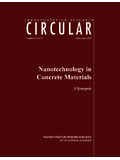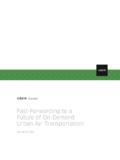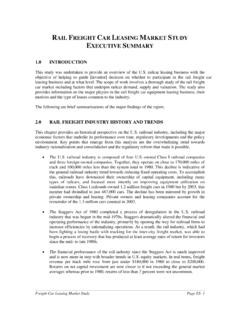Transcription of TransPod Ultra-High-Speed Tube Transportation: …
1 ScienceDirectAvailable online at Engineering 199 (2017) 8 171877-7058 2017 The Authors. Published by Elsevier under responsibility of the organizing committee of EURODYN 2017 The Authors. Published by Elsevier under responsibility of the organizing committee of EURODYN online at Engineering 00 (2017) 000 international conference on structural dynamics , EURODYN 2017 TransPod Ultra-High-Speed Tube Transportation: dynamics of Vehicles and InfrastructureRyan Janzena,b, aTransPod Inc., 101 College St.
2 , Toronto, Ontario M5G1L7, CanadabUniversity of Toronto, Department of Electrical and Computer Engineering,10 King s College Road, Mailroom SFB540, Toronto, Ontario M5S3G4, CanadaAbstractA next-generation mass transportation system, consisting of TransPod aerospace vehicles designed to carry passengers at speedsexceeding 1000 km/h, is presented with respect to dynamics considerations. This system is based on electromagnetic propulsion ofvehicles within a protected tube guideway, whose air pressure is reduced and controlled for improved performance at high tube environment is designed for levitation systems, stability systems, and safety support systems, to permit multiple TransPodvehicles to run simultaneously with high-frequency departures.
3 The design of this vehicle and tube structure is aided by analysisof structural dynamics and aerodynamics, presented in this paper with selected novel topics in physical-fourier-amplitude-domainanalysi s, and machine-learning-based vibration sensing and 2017 The Authors. Published by Elsevier under responsibility of the organizing committee of EURODYN :Tube transportation , Vactrain, Evacuated Tube transportation , Hyperloop, TransPod , Multi-modal dynamics , PFA analysis, AFtransform, High dynamic range sensing, HDR sensing, Veillance flux, Real-time AI, Real-time machine learning, Vortex AI1.
4 IntroductionTube-based vacuum transportation was conceptualized over 100 years ago, as a means to achieve ultra-high-speedground transportation and efficient inter-city travel. An early version was prototyped in 1909 by Boris Weinberg,a Russian professor who built a model of his proposed system at Tomsk Polytechnic University, and published theconcept in 1914 in a book, Motion without friction (airless electric way) [1][2].Robert Goddard, a pioneer of rocket design and one of the forefathers of space exploration, proposed a similarconcept, published in 1909 and 1914 [3].
5 Goddard s system, patented after his death, included vacuum pumps toreduce air pressure in a tunnel guideway, and a vehicle design which was levitated by magnets [4].Nearly 50 years previously, pneumatic railways were an early predecessor to this concept with trains affixed witha baffle moving along inside tubes, while fans created a pressure differential in the tubes to deliver force. Functioningversions of this system were installed in London and New York in the 1860s-70s. TheCrystal Palace Pneumatic Acknowledgments to TransPod staffand others listed Tel.
6 :+ 2017 The Authors. Published by Elsevier under responsibility of the organizing committee of EURODYN online at Engineering 00 (2017) 000 international conference on structural dynamics , EURODYN 2017 TransPod Ultra-High-Speed Tube Transportation: dynamics of Vehicles and InfrastructureRyan Janzena,b, aTransPod Inc., 101 College St., Toronto, Ontario M5G1L7, CanadabUniversity of Toronto, Department of Electrical and Computer Engineering,10 King s College Road, Mailroom SFB540, Toronto, Ontario M5S3G4, CanadaAbstractA next-generation mass transportation system, consisting of TransPod aerospace vehicles designed to carry passengers at speedsexceeding 1000 km/h, is presented with respect to dynamics considerations.
7 This system is based on electromagnetic propulsion ofvehicles within a protected tube guideway, whose air pressure is reduced and controlled for improved performance at high tube environment is designed for levitation systems, stability systems, and safety support systems, to permit multiple TransPodvehicles to run simultaneously with high-frequency departures. The design of this vehicle and tube structure is aided by analysisof structural dynamics and aerodynamics, presented in this paper with selected novel topics in physical-fourier-amplitude-domainanalysi s, and machine-learning-based vibration sensing and 2017 The Authors.
8 Published by Elsevier under responsibility of the organizing committee of EURODYN :Tube transportation , Vactrain, Evacuated Tube transportation , Hyperloop, TransPod , Multi-modal dynamics , PFA analysis, AFtransform, High dynamic range sensing, HDR sensing, Veillance flux, Real-time AI, Real-time machine learning, Vortex AI1. IntroductionTube-based vacuum transportation was conceptualized over 100 years ago, as a means to achieve ultra-high-speedground transportation and efficient inter-city travel.
9 An early version was prototyped in 1909 by Boris Weinberg,a Russian professor who built a model of his proposed system at Tomsk Polytechnic University, and published theconcept in 1914 in a book, Motion without friction (airless electric way) [1][2].Robert Goddard, a pioneer of rocket design and one of the forefathers of space exploration, proposed a similarconcept, published in 1909 and 1914 [3]. Goddard s system, patented after his death, included vacuum pumps toreduce air pressure in a tunnel guideway, and a vehicle design which was levitated by magnets [4].
10 Nearly 50 years previously, pneumatic railways were an early predecessor to this concept with trains affixed witha baffle moving along inside tubes, while fans created a pressure differential in the tubes to deliver force. Functioningversions of this system were installed in London and New York in the 1860s-70s. TheCrystal Palace Pneumatic Acknowledgments to TransPod staffand others listed Tel.:+ 2017 The Authors. Published by Elsevier under responsibility of the organizing committee of EURODYN Engineering 00 (2017) 000 000 Railwayand theBeach Pneumatic Subway, respectively, carried passengers a short distance inside each city [5,6], butthese systems pre-dated the large-scale development of vacuum technology, and could not take advantage of reducedfriction for high-speed inter-city vacuum train (vactrain)





